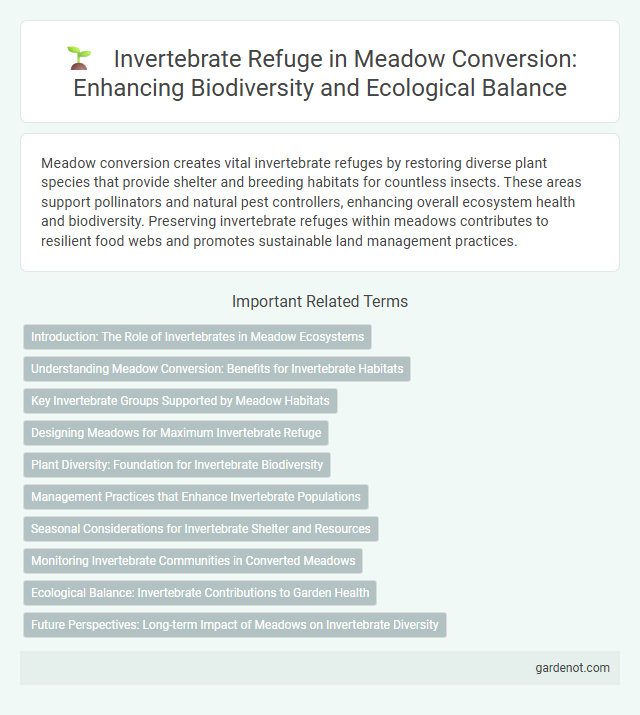Meadow conversion creates vital invertebrate refuges by restoring diverse plant species that provide shelter and breeding habitats for countless insects. These areas support pollinators and natural pest controllers, enhancing overall ecosystem health and biodiversity. Preserving invertebrate refuges within meadows contributes to resilient food webs and promotes sustainable land management practices.
Introduction: The Role of Invertebrates in Meadow Ecosystems
Invertebrates play a crucial role in meadow ecosystems by supporting biodiversity, aiding in pollination, and contributing to nutrient cycling. These organisms act as primary consumers and prey for higher trophic levels, maintaining ecological balance and soil health. Creating invertebrate refuges within meadow conversion projects enhances habitat complexity, fostering resilient and sustainable environments.
Understanding Meadow Conversion: Benefits for Invertebrate Habitats
Invertebrate refuge areas created through meadow conversion enhance biodiversity by providing essential habitats that support pollinators, predators, and decomposers. These habitats increase ecological resilience by promoting nutrient cycling and stabilizing food webs, which benefits overall ecosystem health. Restoring meadows fosters diverse plant species that supply food and shelter for a wide range of invertebrates, crucial for maintaining balanced and thriving ecosystems.
Key Invertebrate Groups Supported by Meadow Habitats
Meadow habitats provide essential refuge for key invertebrate groups such as pollinators, including bees and butterflies, which rely on diverse floral resources for nectar and pollen. Ground beetles and spiders benefit from the structural complexity of meadows, using the vegetation for shelter and hunting grounds. These habitats support a high diversity of detritivores and decomposers like earthworms and springtails, crucial for nutrient cycling and soil health.
Designing Meadows for Maximum Invertebrate Refuge
Designing meadows for maximum invertebrate refuge involves creating structurally diverse habitats with varied plant species that provide essential shelter and foraging opportunities. Incorporating native wildflowers, grasses, and low-growing shrubs enhances microhabitats vital for pollinators, beetles, spiders, and other beneficial invertebrates. Maintaining undisturbed areas with leaf litter, dead wood, and bare soil patches further supports invertebrate biodiversity and ecosystem resilience.
Plant Diversity: Foundation for Invertebrate Biodiversity
Plant diversity in meadows plays a critical role in supporting invertebrate biodiversity by providing essential habitats and food sources for various species. Diverse native wildflowers and grasses create microhabitats that shelter pollinators, decomposers, and predators, enhancing ecosystem resilience. Maintaining heterogeneous plant communities promotes invertebrate refuge, ensuring ecological balance and long-term meadow health.
Management Practices that Enhance Invertebrate Populations
Implementing rotational mowing and reduced pesticide use significantly enhances invertebrate refuges within meadow conversions by preserving habitat complexity and food availability. Establishing buffer strips with native wildflowers supports diverse pollinator and predatory insect populations critical for ecosystem balance. Integrating deadwood and maintaining leaf litter layers further provides essential microhabitats, promoting invertebrate biodiversity and ecological resilience.
Seasonal Considerations for Invertebrate Shelter and Resources
Seasonal variations significantly influence the availability of shelter and resources in invertebrate refuges within meadow conversions, as many species rely on leaf litter, dead wood, and flowering plants for overwintering and breeding. Ensuring a continuous supply of diverse habitat structures, such as native wildflowers blooming at different times and undisturbed soil patches, supports invertebrate populations throughout spring to autumn. Maintaining moisture levels and microhabitats during dry or cold periods enhances survival rates and contributes to the overall biodiversity resilience in converted meadow ecosystems.
Monitoring Invertebrate Communities in Converted Meadows
Monitoring invertebrate communities in converted meadows is essential for assessing ecosystem health and biodiversity restoration success. Methods such as pitfall traps, sweep netting, and soil sampling provide comprehensive data on species richness, abundance, and community composition. Long-term monitoring enables detection of population trends and informs adaptive management strategies to enhance invertebrate refuges within meadow habitats.
Ecological Balance: Invertebrate Contributions to Garden Health
Invertebrate refuges within meadow conversions enhance ecological balance by supporting diverse populations of pollinators, decomposers, and natural pest controllers essential to garden health. These habitats increase soil fertility and promote plant growth by facilitating nutrient cycling and organic matter breakdown. Encouraging invertebrate diversity reduces reliance on chemical inputs, fostering a sustainable and resilient garden ecosystem.
Future Perspectives: Long-term Impact of Meadows on Invertebrate Diversity
Meadow conversion creates critical invertebrate refuges that enhance habitat complexity and resource availability, promoting biodiversity resilience. Long-term monitoring indicates sustained increases in species richness and population stability for key invertebrate groups such as pollinators and decomposers. Integrating meadow conservation into landscape management can support ecosystem functions and bolster invertebrate diversity amid environmental change.
Invertebrate refuge Infographic

 gardenot.com
gardenot.com